Thai cuisine, renowned for its bold flavors and aromatic dishes, offers a diverse range of options that cater to all palates. Among the many beloved dishes, Pad See Ew and Pad Kee Mao are two tantalizing noodle dishes that have gained significant global popularity. At first glance, these dishes may seem quite similar with their stir-fried noodles, a mix of proteins, and veggies. But, dig a bit deeper, and you’ll discover a world of unique flavors and textures that differentiate these two Thai delicacies. This article will take you on a culinary journey, exploring the distinctive characteristics, flavors, and health benefits of both Pad See Ew and Pad Kee Mao, to help you determine which noodle delight is your perfect match.
Pad See Ew Vs Pad Kee Mao!
The main difference between Pad See Ew and Pad Kee Mao lies in the flavor profiles and types of noodles used in these dishes. Pad See Ew, often referred to as Thai stir-fried soy sauce noodles, is typically milder and sweeter. It is made with wider rice noodles, commonly known as Sen Yai, stir-fried with soy sauce, a choice of protein (chicken, beef, tofu), Chinese broccoli, and eggs.
On the other hand, Pad Kee Mao, or “Drunken Noodles”, is known for its fiery flavor, using thinner rice noodles stir-fried with a blend of soy sauces, fish sauce, a choice of protein, bell peppers, onions, basil, and an abundance of chili. Its name derives from its reputation as a spicy hangover cure, making it a spicier and more aromatic dish than Pad See Ew.
The Spice Factor in Pad Kee Mao and Pad See Ew
When comparing Pad Kee Mao and Pad See Ew, one cannot overlook the contrasting levels of spice. Pad Kee Mao, also referred to as ‘Drunken Noodles’, packs a punch when it comes to heat. This is primarily because it uses a generous amount of chilies and chili paste, creating a fiery yet delightful experience. On the other hand, Pad See Ew is much milder, relying on a blend of soy sauces for its flavor. It often does not include chilies, making it a more suitable option for those who prefer a less spicy dish. However, the spice level can always be adjusted according to personal preference in both dishes.
The Role of Vegetables in Pad See Ew Vs Pad Kee Mao
The choice of vegetables used in these dishes greatly contributes to their distinct tastes and textures. Pad See Ew traditionally uses Chinese broccoli, which offers a nice crunch and subtle bitter note that complements the sweet and savory sauce. On the other hand, Pad Kee Mao incorporates a wider range of vegetables, including bell peppers, onions, and most importantly, Thai basil. The basil contributes a unique anise-like flavor and aroma, setting it apart from Pad See Ew. The use of various vegetables in Pad Kee Mao adds complexity and depth to the overall flavor profile.
The Influence of Protein Choices on Pad Kee Mao Vs Pad See Ew
The selection of protein in both dishes can dramatically impact their flavor and texture. Both Pad See Ew and Pad Kee Mao can be prepared with a variety of proteins like chicken, beef, tofu, or prawns. However, the choice of protein can influence the dishes’ savoriness. For instance, beef or chicken might give a more robust and hearty flavor, while tofu could make the dish lighter. Furthermore, the protein is marinated and stir-fried in each dish, absorbing the sauces’ flavors, and adding to the dish’s overall complexity.
Sauce Variations Between Pad See Ew Vs Pad Kee Mao
Lastly, the sauces used in Pad See Ew and Pad Kee Mao greatly determine their flavor profiles. Pad See Ew utilizes a blend of light and dark soy sauces, sugar, and sometimes oyster sauce, lending it a sweet and savory taste. In contrast, Pad Kee Mao’s sauce is a combination of dark soy sauce, light soy sauce, fish sauce, and oyster sauce. The fish sauce adds an umami flavor, and when combined with chilies and sugar, it creates a perfect balance of spicy, sweet, salty, and savory. The key to both dishes is the harmonious blend of these sauces, bringing out the best of each ingredient and creating a memorable eating experience.
What is Pad See Ew? An In-Depth Look
Pad See Ew, which translates to “stir-fried soy sauce noodles,” is a popular street food dish in Thailand. It’s made with wide rice noodles called Sen Yai, stir-fried with a flavorful mix of light and dark soy sauce, sugar, and occasionally oyster sauce.
The dish traditionally includes a protein source, usually chicken, beef, pork, or tofu, and is complemented by the crunch of Chinese broccoli. Eggs are scrambled into the mix, offering a richer taste and creamier texture to the stir-fried noodles. Pad See Ew’s charm lies in its simplicity, characterized by its balance of sweet, salty, and umami flavors, with a mild, non-spicy profile.
The Flavors of Pad Kee Mao Uncovered
Pad Kee Mao, often known as “Drunken Noodles,” is a Thai noodle dish celebrated for its robust and fiery flavors. Although the dish’s name suggests a connection with alcohol, it’s believed to be so named because of its spiciness, which would require a drink on the side.
Made with thinner rice noodles, the dish is stir-fried with a choice of protein, bell peppers, onions, and a liberal handful of Thai basil. The basil, coupled with chilies and a sauce composed of soy sauce, fish sauce, and a touch of sugar, gives the dish its unique hot, sweet, and savory profile. Pad Kee Mao is notably spicier than Pad See Ew, offering a harmonious medley of vibrant flavors.
Key Ingredients in Pad See Ew and Pad Kee Mao
Though Pad See Ew and Pad Kee Mao share some similarities in their ingredients, their unique components contribute to their distinct flavors. Key ingredients in Pad See Ew include wide rice noodles (Sen Yai), light and dark soy sauces, a choice of protein, Chinese broccoli, eggs, and garlic.
On the other hand, Pad Kee Mao is characterized by its use of thinner rice noodles, a mix of soy sauces, fish sauce, protein of choice, a medley of vegetables like bell peppers and onions, Thai basil, and a generous amount of chilies. Garlic and sugar are common ingredients in both dishes to balance the flavors.
Pad See Ew vs Pad Kee Mao: Comparing Flavors and Textures
When comparing Pad See Ew and Pad Kee Mao, the differences in flavors and textures are quite pronounced. Pad See Ew is typically sweeter and milder, with the wide, flat noodles providing a pleasing chewy texture. The Chinese broccoli gives a crunchy contrast, and the scrambled eggs lend a velvety richness to the dish.
Pad Kee Mao, in contrast, is spicier and more complex in flavor. The use of thinner noodles allows them to absorb more of the sauce, providing a more pronounced flavor in each bite. The Thai basil in Pad Kee Mao imparts a unique anise-like flavor and aroma, and the blend of vegetables provides varied textures, making each mouthful a new experience. The choice between Pad See Ew and Pad Kee Mao usually comes down to personal preference for heat and complexity of flavors.
Health Benefits: Pad See Ew and Pad Kee Mao
Both Pad See Ew and Pad Kee Mao, like many Thai dishes, have certain health benefits derived from their key ingredients.
Pad See Ew is packed with protein from your choice of chicken, beef, pork, or tofu. The Chinese broccoli used provides a good source of vitamins A, C, and K, as well as minerals like iron and calcium. However, due to the inclusion of sugar and soy sauce, Pad See Ew can be high in sodium and carbs, so moderation is key.
Pad Kee Mao also offers nutritional benefits. The protein in Pad Kee Mao provides essential amino acids, while the various vegetables add fiber and a range of vitamins. Thai basil, a significant ingredient, has anti-inflammatory and antibacterial properties. It’s also a good source of vitamin K. Like Pad See Ew, Pad Kee Mao can also be high in sodium due to the sauces, and the spice level may not be suitable for everyone.
Customizing Your Thai Noodles: Variations of Pad See Ew and Pad Kee Mao
Thai dishes like Pad See Ew and Pad Kee Mao are incredibly flexible, allowing for several adaptations based on dietary preferences or available ingredients.
For Pad See Ew, you can switch out Chinese broccoli for other greens like bok choy or regular broccoli. The choice of protein is also flexible – shrimp, squid, or even duck could add a different flavor dimension. Vegetarians can use tofu as a protein source and swap out oyster sauce for a vegetarian version.
Pad Kee Mao can be customized similarly. While the traditional recipe calls for a mix of bell peppers and onions, you can experiment with other vegetables like snap peas, mushrooms, or baby corn. The choice of protein is flexible as well, and for those who love fiery dishes, adding more chilies can turn up the heat.
Final Verdict: Choosing Between Pad See Ew and Pad Kee Mao
Choosing between Pad See Ew and Pad Kee Mao boils down to personal taste preference. If you prefer a milder, slightly sweet dish with wide chewy noodles and a less complex flavor profile, then Pad See Ew is a great choice. On the other hand, if you’re a fan of spicy food, enjoy a medley of flavors, and prefer thinner noodles that absorb more sauce, Pad Kee Mao will be a delight.
Both dishes have their unique charms and represent the diversity of Thai cuisine wonderfully. So, whether it’s the sweet and savory Pad See Ew or the fiery and aromatic Pad Kee Mao, you’re bound to find joy in every bite. Try them both, and let your palate decide.

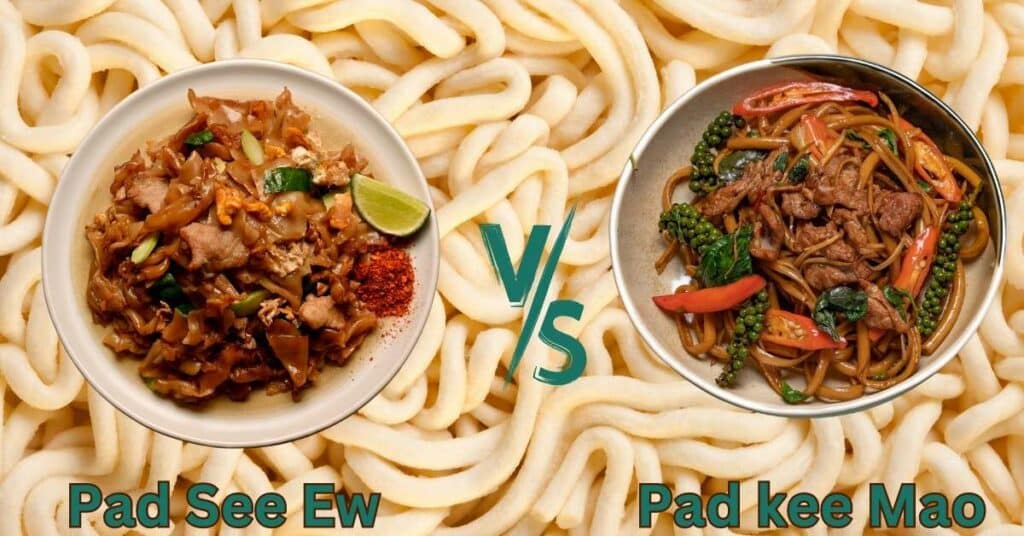


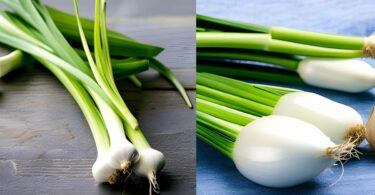
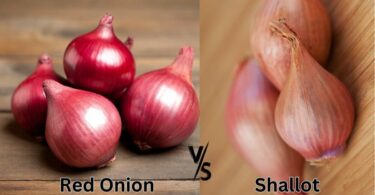
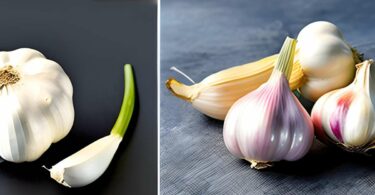
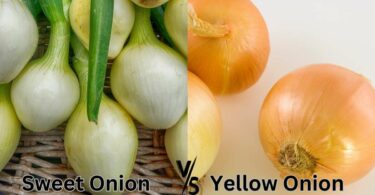
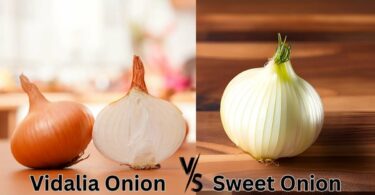
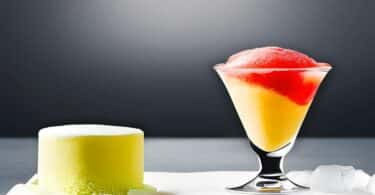
Leave a Comment